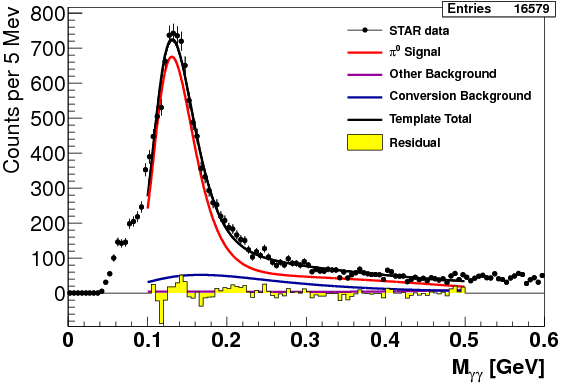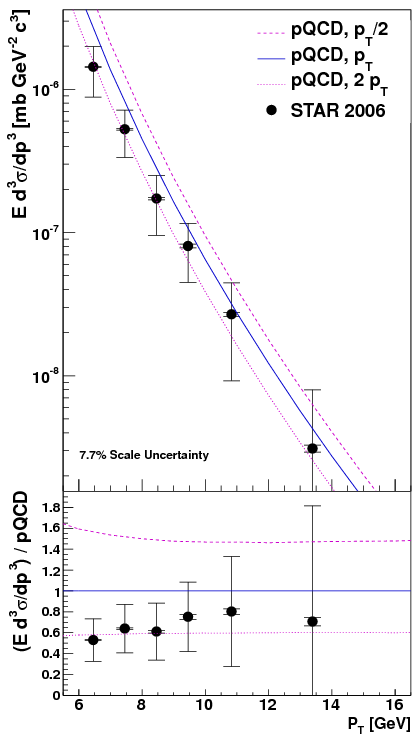Intent to publish 2006 EEMC pi0 paper
Title:
Neutral pion cross section and spin asymmetries at forward rapidity in polarized proton collisions at \sqrt{s} = 200 GeV.
Principal Authors (alphabetical order):
Jim Drachenberg (Valpo), Adam Gibson (Valpo), Stephen Gliske (ANL), Keith Krueger (ANL/Valpo), Dave Underwood (ANL), Jason Webb (BNL), possibly others (Indiana)Intended Journal:
Phys. Rev. D, rapid communication.
Why rapid?
- New:
- Although data was not taken recently, the results are new and will be the first published EEMC results
- Impact/Importance:
- Data covers a unique kinematic range in (eta, pT) and (eta, xF)
- No other instrumentation exists in this kinematic range except the STAR EEMC
- Results expected to impact the global fit for the unpolarized pi0 fragmentation function, and thus the gluon helicity distribution extraction
- Effects GRSV++, which is expected to be coming out on a short time scale
Abstract:
The differential cross section and spin asymmetries for neutral pion production at pseudo-rapidity 0.8 < eta < 2.0 in polarized proton collisions at sqrt(s) = 200 GeV are presented. Data was taken using the endcap electromagnetic calorimeter in the STAR detector at RHIC. The cross section is measured over a transverse momentum range of 6 < p_T < 16 GeV/c and is found to lie between the pT and 2pT scale of a next-to-leading order perturbative QCD calculation. The longitudinal double-spin asymmetry, A_LL, is sensitive to the gluonic contribution to the proton spin, delta G, and probes a lower x range than mid-rapidity measurements. The measured A_LL is consistent with model predictions. The transverse spin asymmetry, A_N, includes contributions from Sivers and Collins effects, and this measurement spans a unique kinematic range in x_F and p_T. The A_N results presented are consistent with zero. The parity violating asymmetry A_L is also measured and found to be consistent with zero.Outline:
- Motiviation
- Experimental Setup and Data Analysis
- Results
- Presentation and discussion of cross section results
- Presentation and discussion of longitudinal asymmetry results
- Presentation and discussion of transverse asymmetry results
- Conclusion
Some possible references
[1] Longitudinal double-spin asymmetry and cross section for inclusive neutral pion production at midrapidity in polarized proton collisions at sqrt(s) = 200 GeV. STAR Collaboration (B.I. Abelev (Illinois U., Chicago) et al.). Phys.Rev. D80 (2009) 111108
[2] Inclusive cross-section and double helicity asymmetry for pi0 production in p + p collisions at s**(1/2) = 200-GeV: Implications for the polarized gluon distribution in the proton. PHENIX Collaboration (A. Adare (Colorado U.) et al.). Phys.Rev. D76 (2007) 051106
[3]Longitudinal double-spin asymmetry for inclusive jet production in p+p collisions at s**(1/2) = 200-GeV.
STAR Collaboration (B.I. Abelev (Illinois U., Chicago) et al.). Oct 2007. 7 pp.
Published in Phys.Rev.Lett. 100 (2008) 232003
[4]Longitudinal and transverse spin asymmetries for inclusive jet production at mid-rapidity in polarized p+p collisions at √s=200 GeV.
STAR Collaboration, Phys.Rev. D86 (2012) 032006
Figure 1: Invarient Mass
We choose to show pT in 8-9 GeV.
Figure 2: Cross Section

For more details regarding the context of these results, see this blog.
Conclusions:
- There exists some tension with the pT scale pQCD results.
- Data falls between pT and 2pT energy scales
- Preference towards the 2 pT energy scale.
- Overall chi^2 / ndf = 2.0 between data and the pT-scale curve
- Worse disagreement at lower pT
- Lowest bins differ by 2.6\sigma, 1.6\sigma and 1.5\sigma
- It is possible we are starting to see signs of non-perturbative effects
- It is also possible that (since this is a previouslyunmeasured pT, phys. eta domain) one can retune some parameters in the pQCD prediction, resulting in good agreement with all the STAR pi0 cross section results.
Figure 3: A_LL vs p_T
.png)
Cosmetics:
- Get new A_LL theory curve (using lines hand copied from Weihong's thesis for now)
- A_LL is consistent with all parameter variations of the theory curves
Figure 4: AN vs xF and pT

Further detail plots here.
Cosmetics:- Decide how to plot systematic uncertainties, and make sure it is consistent throughout
- Consider adding the other published pi0 A_N results (vs xF or possibly also vs pT) from other detectors on the same plot(s).
- A_N is consitent with zero, as expected.
- Data does not have the precision to observe signal in the highest xF bin.
- Data does not have the precision to make strong conclusions about pT dependence of A_N.
- sgliske's blog
- Login or register to post comments
